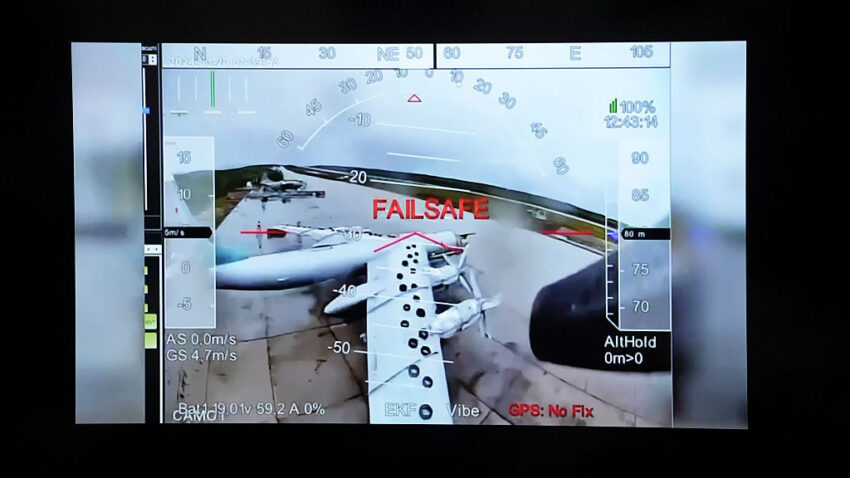A TV screen shows a clip from the Ukraine’s Operation “Spider’s Web” inside Russian territory during a news conference at the Ukrainian Embassy in Washington, DC on June 4, 2025. (Photo by OLIVER CONTRERAS/AFP via Getty Images)
With a single, coordinated attack, Ukraine has crippled at least a dozen Russian aircraft – including around 10 percent of Russia’s bomber fleet – using only small drones.
This drone ambush should trigger alarm bells for the US military. Like Russia, the United States is unprepared to meet the growing threat of small commercial drones.
The audacious Ukrainian “Spider’s Web” operation was 18 months in the making. Operatives with the Security Service of Ukraine smuggled 117 first-person view (FPV) quadcopters into Russia, transporting them in crates and driving them thousands of miles in semi-trucks. On the day of the attack, the trucks stationed in a handful of locations in different parts of Russia released swarms of the small, fast drones, guided by goggle-clad pilots to crash into parked AT-50 airborne warning aircraft, and Tu-95 and Tu-22M bombers.
Ukraine has launched regular long-range drone strikes into Russia since 2023, but none of them have caused as much damage as the June 1 attacks.
More Coverage of Ukraine’s Drone Attack:
- Zelenskyy’s drone card: How Operation Spiderweb impacts Russia’s capabilities going forward
- Pentagon chiefs eye Ukraine’s surprise drone strike with anxiety – and envy
Small drones flown by skilled pilots can cripple soft targets like unsheltered aircraft with less than five pounds of explosives. Because drones can independently navigate to multiple targets over a large area, a coordinated swarm attack can inflict more damage than a single missile or large strike drone.
Swarming attacks like those launched by Ukraine are an inexpensive way to precisely deliver area effects that previously could only be achieved with cluster missiles. Furthermore, the large, slow-flying drones typically used in standoff strikes are often shot down, but the maneuverable, fast-flying FPVs are difficult to detect and intercept.
Despite the ubiquity of small FPV drones on the frontlines, the Russian military has been seemingly unconcerned about this threat against its interior bases. They were surprised that covert Ukrainian operatives had infiltrated deep inside of Russia near some of its most sensitive military installations.
The United States cannot afford to similarly be caught by surprise and can no longer be complacent to the threat posed by small drones abroad and at home. This attack is wake-up call for US military: its counter-drone efforts are inadequate and are not keeping pace with the threat.
Bases, equipment, troops — every element of a deployed American force will be at risk of drone attack in any future conflict. US defense systems are barely sufficient against current low-end drones that are typically fired in ones or twos and would be quickly overwhelmed by autonomous drone swarms or large, sophisticated attacks.
Bases in the US homeland likewise must also be defended against a surprise drone barrage. Though not in coordinated swarms, hundreds of small drone incursions occur each year around US bases. In 2023, small drones flew over Langley Air Force base 17 times, observing F-22 stealth fighters parked, uncovered, on the tarmac. Though there has not been a drone attack on a base inside the United States, once could occur at any time and American aircraft are sitting ducks.
Defeating drones requires a robust layered defensive system with protective measures, such as hardened shelters, and offensive counter drone systems. Early warning sensors that help to identify drones are the foundation of any defensive system, but priority installations also need weapons that can disable or destroy a drone, such as jammers, guns, and missiles.
Only high-powered microwaves can neutralize a large swarm at once and are not dependent on ammunition stockpiles. Thus, multiple types of counter-drone systems are needed to work together, so that they cannot easily be circumvented by a skillful adversary.
Perhaps most importantly, however, is a command-and-control system with AI to integrate the layered defenses, process sensor data for positive threat identification, and to automate the engagement process. This would enable operations at the speed required to successfully intercept fast-moving drones and large attacks. Countering drones is particularly difficult in the homeland, as American troops abroad can often shoot down drones, but inside the United States low-collateral defeat approaches are necessary to ensure civilian and airspace safety.
On paper, the Defense Department has made defeating small drones an imperative since 2016, but, in reality, the response has been slow and inadequate. The small drone threat is already here, and it will only intensify.
While Golden Dome for America has brought renewed focus on homeland defense at the highest levels of government, there is a risk that it will exclusively focus on defeating high-end missiles and neglect small drones.
On Friday President Trump released an executive order on countering drones and restoring airspace sovereignty, but more investment is urgently needed to reduce current vulnerabilities. The details of the 2026 presidential defense budget request have yet to be released, and Congress has an opportunity to act in defense of American forces at home and abroad.
Congress must authorize and appropriate adequate funding for comprehensive counter-drone defense training and improved air and drone defense technologies. The United States needs to learn from Russia’s monumental failure and make countering drones a priority, or risk suffering the same fate.
Stacie Pettyjohn is a senior fellow and director of the Defense Program at the Center for a New American Security, where Molly Campbell is a research assistant.
Click this link for the original source of this article.
Author: Stacie Pettyjohn and Molly Campbell
This content is courtesy of, and owned and copyrighted by, https://breakingdefense.com and its author. This content is made available by use of the public RSS feed offered by the host site and is used for educational purposes only. If you are the author or represent the host site and would like this content removed now and in the future, please contact USSANews.com using the email address in the Contact page found in the website menu.








